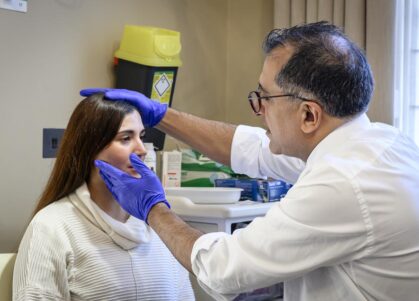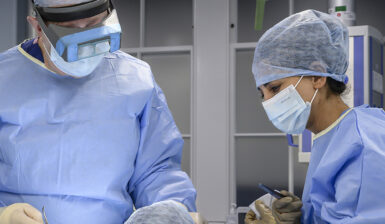Causes & Symptoms
TMJ disorders, which affect the jaw joint, are slightly more common in women than men. While they can occur at any age, they’re more often seen in people during middle age. Some causes, like arthritis, tend to develop as we get older.
In many cases, symptoms are caused by a mild condition known as temporomandibular joint dysfunction (TMD). This can often improve with rest, lifestyle changes, and avoiding habits that strain the jaw. However, some people may still need treatment depending on how their symptoms progress.
More serious cases can involve problems like jaw dislocation or misalignment between the joint surfaces. These issues can be caused by habits like teeth grinding, jaw clenching, or overuse of the jaw muscles.
TMJ problems can also be the result of injuries, such as a fracture, or inflammation linked to conditions like rheumatoid arthritis or osteoarthritis.
Common symptoms include pain in the jaw joint, face, neck, or head, as well as stiffness, limited jaw movement, and clicking or popping sounds when opening or closing the mouth. In some cases, there may be swelling. Other possible symptoms include headaches, tinnitus (ringing in the ears), or even hearing issues.
Although natural misalignment of the teeth isn’t usually the main cause, joint problems can sometimes affect how your upper and lower teeth fit together.
Because there are many possible causes of TMJ problems, a careful and accurate assessment is important. This helps ensure you get the right treatment to relieve symptoms and restore comfort.
Professional Diagnosis
Our specialist maxillofacial consultant will carry out a detailed oral examination. Panoramic X-Rays, or other specialist imaging techniques may be required, to define the detail of your jaw, joints and surrounding soft tissues.
Your medical history, including any relevant family medical history might be discussed, as genetic factors can have a relationship with TMJ disorder.
Issues such as mouth sores, gum disease, sinus function, or unexplained toothache will be investigated as will previous trauma to the face, or jaw, including biting hard, or unusually wide mouth opening.
Your jaw joints and nearby areas can be examined for pain, clicking, popping, or grating, and your bite and facial muscle function will be analysed during a consultation.
Jaw problems can create stress, tension, headaches, or pain which transfers into your shoulders. Each are symptoms which deserve investigation and are quite common in relation to TMJ disorders.
For such a vital function, examining multiple potential causes will help to ensure that decisions on treatment are the right ones for you.
A Range Of Treatment
Developing a Personalised Treatment Plan
Your clinical assessment including examination findings, imaging results if carried out and your consultant’s expertise will contribute to creating a precise treatment plan. The ethos of our clinic is to minimise surgery, we tend to manage TMJ symptoms conservatively.
Non-Surgical Approaches
Relaxation techniques can assist, as can dietary changes, or jaw joint physiotherapy. Stopping jaw clenching, grinding, or nail biting can address the problem. A clear plastic splint is available to fit over your teeth, worn at night, to support the temporomandibular joints and decrease grinding.
A procedure called Occlusal Equilibration can be used with gentle reshaping of the biting surfaces of individual teeth, to create a more even bite. Other dental work can achieve bite balance, such as replacing missing teeth.
Antidepressant medication may assist, not simply because psychological factors could be involved, the medication has a muscle relaxing and pain killing effect.
Minimally Invasive Surgical Options
Surgery is available but only in a small proportion of cases. This ranges from simple steroid injections into the joint, washing the joint out with sterile fluid, eliminating tissue adhesion, or dislodging a stuck cartilage disc.
When Major Surgery is Necessary
Significant open joint surgery is rarer. This may be indicated if bones within the jaw joint are notably deteriorating, a tumour is found to be a cause, or severe scarring, or bone chips lay inside the joint.
Surgery can include replacing the joint with a modern implant, to be considered where damage, injury, arthritis, infection, or pain cannot be solved in other ways.
Your consultant will counsel you on any procedure that may be needed and discuss this thoroughly. Even in expert hands, open joint surgery brings a greater healing time and some possibility of nerve injury.
Care At Our London Clinic
Seeing a leading maxillofacial consultant is a critical first step in assessing and managing TMJ conditions to ensure the right treatment plan is put in place.
Where a TMJ disorder is the primary issue, your treatment will focus on minimum intervention for maximum effect. A high level of care should be based on full recovery, without unnecessary risks.
We appreciate the loss of function and the pain that TMJ disorders can bring as well as the impact on core activities such as eating, or speaking. Our team is here to help get you back to normal function as quickly as possible.







